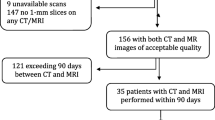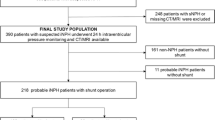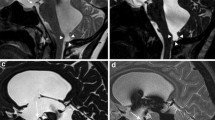Abstract
Introduction
The aim of this study was to determine the performance of axial and coronal magnetic resonance imaging (MRI) in detecting the narrowing of the cerebrospinal fluid (CSF) space at the high convexity and high midline areas, which is speculated to be one of the clinical characteristics of idiopathic normal pressure hydrocephalus (iNPH).
Methods
We retrospectively examined axial and coronal T1-weighted images of 14 iNPH patients and 12 age-matched controls. The narrowness of the CSF space at the high convexity/midline was blindly evaluated by five raters using a continuous confidence rating scale for receiver operating characteristic (ROC) analysis.
Results
Axial and coronal imaging accurately determined the presence of the narrow cisterns/sulci at the high convexity/midline and was capable of predicting probable/definite iNPH with a high degree of accuracy. there were also no significant differences in the detection of this finding between the axial and coronal images.
Conclusion
Both axial and coronal T1-weighted MRI can detect the narrow CSF space at the high convexity/midline accurately and may therefore facilitate clinicians in choosing a management strategy for iNPH patients.


Similar content being viewed by others
References
Relkin N, Marmarou A, Klinge P, Bergsneider M, Black PM (2005) Diagnosing idiopathic normal-pressure hydrocephalus. Neurosurgery 57[Suppl]:4–16
Kitagaki H, Mori E, Ishii K, Yamaji S, Hirono N, Imamura T (1998) CSF spaces in idiopathic normal pressure hydrocephalus: morphology and volumetry. Am J Neuroradiol 19:1277–1284
Ishikawa M (2004) Clinical guidelines for idiopathic normal pressure hydrocephalus. Neurol Med Chir 44:222–223
Evans WA (1942) An encephalographic ratio for estimating ventricular and cerebral atrophy. Arch Neurol Psychiatr 47:931–937
Metz CE, Herman BA, Shen JH (1998) Maximum-likelihood estimation of receiver operating characteristic (ROC) curves from continuously-distributed data. Stat Med 17:1033–1053
Walchenbach R, Geiger E, Thomeer RT, Vanneste JA (2002) The value of temporary external CSF drainage in predicting the outcome of shunting on normal pressure hydrocephalus. J Neurol Neurosurg Psychiatr 72:503–506
Kahlon B, Sundbarg G, Rehncrona S (2002) Comparison between the lumbar infusion and CSF tap tests to predict outcome after shunt surgery in suspected normal pressure hydrocephalus. J Neurol Neurosurg Psychiatr 73:721–726
Vassilouthis J (1984) The syndrome of normal-pressure hydrocephalus. J Neurosurg 61:501–509
Krauss JK, Regel JP, Vach W, Orszaph M, Jungling FD, Bohus M, Droste DW (1997) White matter lesions in patients with idiopathic normal pressure hydrocephalus and in an age-matched control group: a comparative study. Neurosurgery 40:491–495
Jack CR, Mokri B, Laws ER, Houser OW, Baker HL, Petersen RC (1987) MR findings in normal-pressure hydrocephalus: significance and comparison with other forms of dementia. J Comput Assist Tomogr 11:923–931
Luetmer PH, Huston J, Friedman JA, Dixon GR, Petersen RC, Jack CR, McClelland RL, Ebersold MJ (2002) Measurement of cerebrospinal fluid flow at the cerebral aqueduct by use of phase-contrast magnetic resonance imaging: technique and validation and utility in diagnosing idiopathic normal pressure hydrocephalus. Neurosurgery 50:534–543
Kristensen B, Malm J, Fagerland M, Hietala SO, Johansson B, Eksttedt J, Karlsson T (1996) Regional cerebral blood flow, white matter abnormalities, and cerebrospinal fluid hydrodynamics in patients with idiopathic adult hydrocephalus syndrome. J Neurol Neurosurg Psychiatr 60:282–288
Tullberg M, Jensen C, Ekholm S (2001) Normal pressure hydrocephalus: vascular white matter changes on MR images must not exclude patients from shunt surgery. Am J Neuroradiol 22:1665–1673
Vanneste J, Augustijn P, Davies GA, Dirven C, Tan WF (1992) Normal-pressure hydrocephalus; is cisternograpphy still useful in selecting patients for a shunt? Arch Neurol 49:366–370
Bateman GA, Levi CR, Schofield P, Wang Y, Lovett EC (2005) The pathophysiology of the aqueduct stroke volume in normal pressure hydrocephalus: can co-morbidity with other forms of dementia be excluded? Neuroradiology 47:741–748
Adachi M, Kawanami T, Ohshima F, Kato T (2006) Upper midbrain profile sign and cingulate sulcus sign: MRI findings on sagittal images in idiopathic normal-pressure hydrocephalus, Alzheimer’s disease, and progressive supranuclear palsy. Radiat Med 24:568–572
Bradley WG, Bahl G, Alksne JF (2006) Idiopathic normal pressure hydrocephalus may be a “two hit” disease: benign external hydrocephalus in infancy followed by deep white matter ischemia in late adulthood. J Magn Reson Imaging 24:747–755
Acknowledgements
This work was partly supported by a Research Grant from the Ministry of Health, Labour and Welfare of Japan (2005-Nanchi-17) and by a Grant-in-Aid for Advanced Medical Science Research from the Ministry of Education, Culture, Sports, Science and Technology of Japan.
Conflict of interest statement
We declare that we have no conflict of interest.
Author information
Authors and Affiliations
Corresponding author
Rights and permissions
About this article
Cite this article
Sasaki, M., Honda, S., Yuasa, T. et al. Narrow CSF space at high convexity and high midline areas in idiopathic normal pressure hydrocephalus detected by axial and coronal MRI. Neuroradiology 50, 117–122 (2008). https://doi.org/10.1007/s00234-007-0318-x
Received:
Accepted:
Published:
Issue Date:
DOI: https://doi.org/10.1007/s00234-007-0318-x




